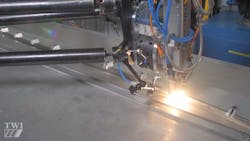LaserTAU project has goal of improved laser welding for aerospace
The Welding Institute (TWI; Cambridge, England) has been working as part of a consortium to apply a new TAU platform for large-envelope, high-end applications. LaserTAU combines laser processing improvements (higher productivity in manufacturing aerospace structures) with large-scale, cost-effective improvements of a TAU robot platform, compared to existing commercially available manipulators.
Working with CAV from the UK and Prodtex, Cognibotics, and Corebon from Sweden, the three-year Innovate UK and Vinnova project used parallel-kinematic machine (PKM) principles in the creation of a new prototype robot that was adapted to create a system able to process workpieces with an envelope of around 3 × 1 × 1 m.
Originally designed for the aerospace industry, it is capable of being deployed to process structures or components in a range of other industry sectors, such as manufacturing of automotive battery cases.
The LaserTAU project consortium demonstrated a long working envelope faster, cheaper, and with a higher precision than other robotic welding techniques. The new platform can deliver extreme accuracy (<10 µm), high stiffness, a large open workspace, and reconfigurable on-site capabilities to manufacture aerospace structures.
This video shows the technology in use on a long weld for the aerospace industry:
